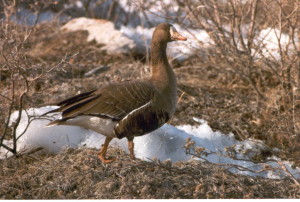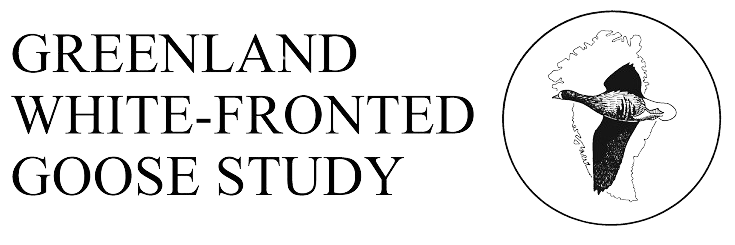1979 Greenland Landscape from Anne Fox on Vimeo.
Video from the first expedition to Greenland to ring birds; flight to Greenland & drop of food supplies followed by landscape pan. Thanks to Adrian Fowles
What is the Greenland White-fronted goose?
The Greenland White-fronted Goose, anser albifrons flavirostris, breeds in west Greenland, and migrates via Iceland to winter in Ireland and Britain. It is the most distinctive race of the circumpolar White-fronted Goose that nests throughout most of northern Russia, Arctic Canada and Alaska.
Conservation concerns
The Greenland White-fronted Goose has been of conservation concern for many years. Declines from the 1950s to the late 1970s resulted in debate about its effective protection and the creation of the Greenland White-fronted Goose Study in 1978 and the initiation of studies on the breeding grounds in Greenland. The process also forged an excellent collaboration between a wide range of enthusiasts, non-government organisations and government departments which continues to the present day.
Legal Protection
The law was changed to protect the population from hunting in Ireland and Scotland from 1983 onwards, and a network of observers was established in 1982 to undertake regular winter counts at all the known haunts to monitor the changes in abundance of the entire population.
Research
A programme of research was also initiated which included regular capture and marking of individuals at Wexford Slobs by the National Parks and Wildlife Service in Ireland. Under protection from hunting, numbers doubled to peak at 35,600 in 1999, but the status of individual flocks and of the population as a whole has changed radically and there has been considerable interest in the patterns of such changes and their causes. Since that time, numbers have again begun to decline, falling to 23,200 by winter 2008/9. 
The website
This web site was created to provide a source of information relating to the Greenland White-fronted Goose available online. Much of the information is presented in the form of the report of 12 years of monitoring which was produced in 1994. However, a great deal has happened since that time, and particularly in recent years, the declines in numbers have given particular cause for concern. For this reason we have created a site inventory which built on the previous site profiles presented in the 12 year report, providing long term perspectives in numbers and production of young for each site, as well as an analysis of the challenges to successful conservation of the goose flocks at each resort.
It is our intention to update this information as time allows and to add more current and historic material as time goes on. We will also hope to review progress in research and conservation that has been made over the years and the conservation challenges and information requirements which still remain to be addressed. Until now, much of the information has been presented piecemeal in national annual reports and publications.
We provide access to these in the bibliography in the site, and hope in future to put more of these resources on the web site for wider accessibility. The intention will continue to be to provide information for the benefit of the people who are good enough to give up considerable amounts of time to watch, study and count Greenland White-fronted Geese, often in very remote areas and all too frequently in poor conditions.
To this end, we want to keep folk informed of recent developments and we also provide a regularly updated listing of individually marked birds seen away from the Wexford Slobs where the majority of have been captured. Although the emphasis is therefore very much on the information relating to count data, we have tried to incorporate more general accounts of information from other aspects of the various research programmes involved, in order to give a backdrop against which the count information can be viewed.
